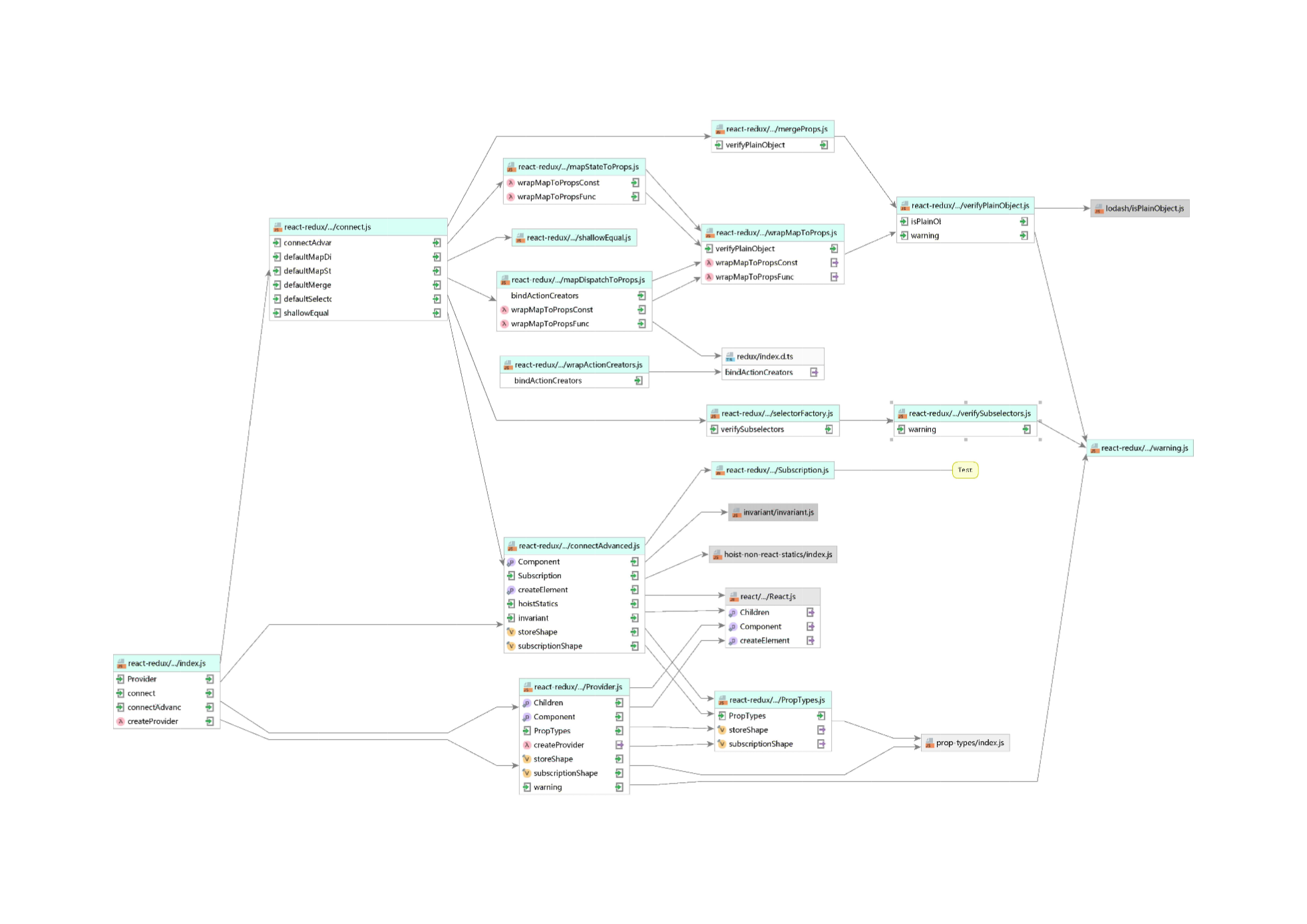Overview
首先看一张图:

可以看到入口文件里面引入了这几个模块:
- Provider
- connectAdvanced
- connect
我们就来依次看一下这几个模块
Provider
将 store 挂在在了 context 上面,给予了子组件访问 store 的能力。
connectAdvanced
一个用来生成 connect 的高阶函数,引用了以下模块:
import { Component, createElement } from "react";
import hoistStatics from "hoist-non-react-statics";
import invariant from "invariant";
import { storeShape, subscriptionShape } from "../utils/PropTypes";
import Subscription from "../utils/Subscription";Subscription
首先看一下 Subscription 模块。
createListenerCollection
实现一个订阅发布模式,提供 clear,notify,subscribe 方法。分别用来清除当前队列,触发事件,订阅方法。
Subscription
订阅类,订阅 onStateChange 事件,同时确保当父级也有事件订阅时,事件触发时,先触发父级事件,然后再触发当前组件事件。
makeSelectorStateful(sourceSelector,store)
function makeSelectorStateful(sourceSelector, store) {
// wrap the selector in an object that tracks its results between runs.
const selector = {
run: function runComponentSelector(props) {
try {
const nextProps = sourceSelector(store.getState(), props);
if (nextProps !== selector.props || selector.error) {
selector.shouldComponentUpdate = true;
selector.props = nextProps;
selector.error = null;
}
} catch (error) {
selector.shouldComponentUpdate = true;
selector.error = error;
}
},
};
return selector;
}selector 用来通过 state 和 prop 来计算出下一个状态的 props,然后传递给连接的组件。 此函数是对 selector 的封装,在计算 props 的基础上,并记录上一次计算的结果。
connectAdvanced(selectorFactory,{options})
connectAdvanced 的功能主要是根据传入的 selectorFactory, options 返回用于生成 Connect 组件一个高阶组件。
connect
class Connect extends Component {
constructor(props, context) {
super(props, context)
...
this.initSelector()
this.initSubscription()
}
...
initSelector() {
const sourceSelector = selectorFactory(this.store.dispatch, selectorFactoryOptions)
this.selector = makeSelectorStateful(sourceSelector, this.store)
this.selector.run(this.props)
}
initSubscription() {
if (!shouldHandleStateChanges) return
// parentSub's source should match where store came from: props vs. context. A component
// connected to the store via props shouldn't use subscription from context, or vice versa.
const parentSub = (this.propsMode ? this.props : this.context)[subscriptionKey]
this.subscription = new Subscription(this.store, parentSub, this.onStateChange.bind(this))
// `notifyNestedSubs` is duplicated to handle the case where the component is unmounted in
// the middle of the notification loop, where `this.subscription` will then be null. An
// extra null check every change can be avoided by copying the method onto `this` and then
// replacing it with a no-op on unmount. This can probably be avoided if Subscription's
// listeners logic is changed to not call listeners that have been unsubscribed in the
// middle of the notification loop.
this.notifyNestedSubs = this.subscription.notifyNestedSubs.bind(this.subscription)
}
...
render() {
const selector = this.selector
selector.shouldComponentUpdate = false
if (selector.error) {
throw selector.error
} else {
return createElement(WrappedComponent, this.addExtraProps(selector.props))
}
}
}定义在 connectAdvanced 内部的组件,通过 context 获取 store 中数据,通过 initSelector 方法初始化一个包含初始 store 的 selector, 并通过 initSubscription 方法订阅 store 的变化。 此组件的 render 方法只是一个代理,用来把通过 selector 计算出来的 props 传递给需要包裹的组件。
connect
connect 引入了以下模块:
import connectAdvanced from "../components/connectAdvanced";
import shallowEqual from "../utils/shallowEqual";
import defaultMapDispatchToPropsFactories from "./mapDispatchToProps";
import defaultMapStateToPropsFactories from "./mapStateToProps";
import defaultMergePropsFactories from "./mergeProps";
import defaultSelectorFactory from "./selectorFactory";只是在 connectAdvanced 的基础上,传入了 selectorFactory 和 mapStateToPropsFactories, mapDispatchToProps, mapDispatchToPropsFactories 作为 connectAdvanced 的 options 参数。
defaultSelectorFactory
定义了默认 selector 的行为,用来从传入的 state 中计算下一个状态的 props.
defaultMap xxx To xxx Factories
这类模块用来生成映射到 props 方法的工厂函数,它们的代码如下形式:
import { bindActionCreators } from "redux";
import { wrapMapToPropsConstant, wrapMapToPropsFunc } from "./wrapMapToProps";
export function whenMapDispatchToPropsIsFunction(mapDispatchToProps) {
return typeof mapDispatchToProps === "function"
? wrapMapToPropsFunc(mapDispatchToProps, "mapDispatchToProps")
: undefined;
}
export function whenMapDispatchToPropsIsMissing(mapDispatchToProps) {
return !mapDispatchToProps
? wrapMapToPropsConstant((dispatch) => ({ dispatch }))
: undefined;
}
export function whenMapDispatchToPropsIsObject(mapDispatchToProps) {
return mapDispatchToProps && typeof mapDispatchToProps === "object"
? wrapMapToPropsConstant((dispatch) =>
bindActionCreators(mapDispatchToProps, dispatch),
)
: undefined;
}可以看到,主要引用了 wrapMapToProps 这个模块。
wrapMapToProps
wrapMapToPropsFunc
这个方法是一个通过把 mapToProps 函数包裹起来作为一个代理函数,用来做一下几件事情:
- 检测
mapToProps函数的调用是否依赖与props, 用来供selectorFactory来决定在props变化的时候是否需要重新调用。 - 在第一次调用的时候,如果
mapToProp执行后返回另一个函数,那么处理它,并且把这个返回的函数作为新的mapToProps用来处理后续的调用。 - 当第一次调用的时候,验证调用的结果是否是一个字面量对象。为了能够警告开发者,他们的
mapToProps函数没有返回一个合法的结果。
总结
react-redux 就是一个用来绑定 redux 到 react 的一个库。如果不用 react-redux 的话,直接在 react 里面去用 redux 也是可以的,只是过于麻烦。需要手动监听 store 的变化,并手动执行组件的 render 方法。 react-redux 提供了一个高阶组件 connect 来帮我们做这件事情,而且帮我们做了一些优化。我们需要的只是,提供 mapDispatchToProps 和 mapStateToProps 给需要监听 store 的组件就可以了。
本文发布于 2017年8月4日,最后更新于 2017年8月4日,距今已有 3050 天,文章内容可能已经过时。
